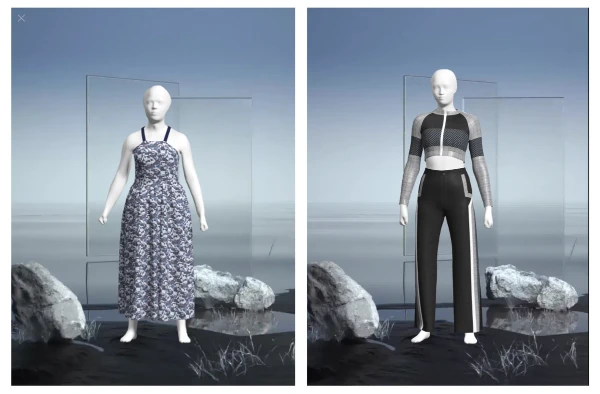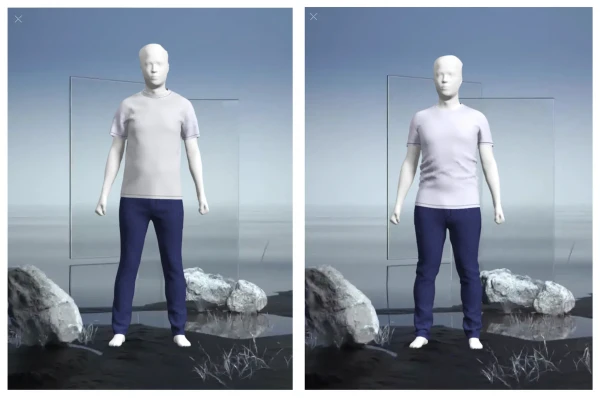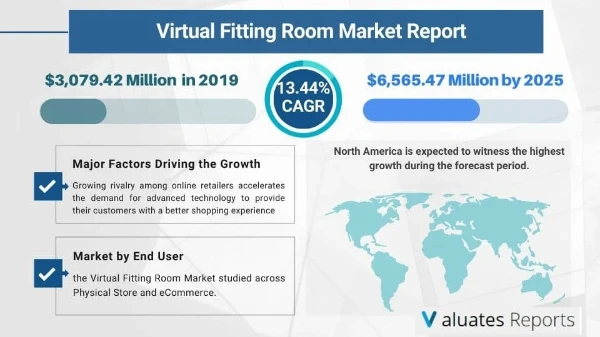Are you tired of the traditional, time-consuming process of trying on clothes in physical stores? Virtual try-on technology is here to transform your shopping experience! Imagine being able to try on clothes virtually, right from the comfort of your own home. In the past, we couldn’t be certain if the clothes fit our bodies, nor could we see how different outfits look on you before making online purchase. Now, say goodbye to the uncertainty of online shopping and embrace a whole new way to shop with confidence!
We discussed about how fashion retailers should continue investing in the coherent omni-channel and phygital shopping experience in the previous blog. However, what exactly does the market need? And how big is the market?
We believe that virtual try-on solution will be the next big thing in the fashion industry. In the following article, we will talk about different types of virtual try-on/fitting room solutions, the benefits and how you can start your own virtual fitting experience with TG3D Studio’s Virtual Try-On Service.
The Virtual Try-On Trend
According to the Valuates Reports, the Global Virtual Fitting Room Market size is expected to grow from USD 3,079.42 Million in 2019 to USD 6,565.47 Million by the end of 2025 at a Compound Annual Growth Rate (CAGR) of 13.44%. The huge rise in online shopping and the growing demands for a consumer-centric mentality is driving the growth of the virtual fitting room market size. In addition, 77% of respondents who have never experienced virtual try-on would like to try it if it were easily available on a retail site. 49%, almost half of respondents, are likely or very likely to buy from a brand if they offer virtual try-on, according to data provided from a recent survey of CSA.
What is Virtual Try-on?
Virtual Try-On is just as its name suggests – the opportunity to try something on virtually, as opposed to putting it on in real life. This has obvious advantages – if you are buying something online it’s great to be able to see what it will look like on you.
The early users of the concept were cosmetics and eyewear companies. Consumers are very comfortable taking selfies and so anything related to the face was pretty easily adopted. Eyeshadow and sunglasses were quite easily digitally added to customers’ faces in a process very similar to adding a filter.
However, the clothing section is catching up and the use of this idea is growing in this sector. It is a little trickier to expand the concept to a whole body, but more advanced technologies are being utilized to provide a more realistic and fun experience.
Types of virtual try-on/ fitting room solutions
Mirror-based Augmented Reality
A Virtual Mirror is a screen that captures full-sized real-time video of the customer standing in front of it – like a mirror – and then overlays the garment of their choice over the image. It can be done right on the shop floor and the customer remains fully clothed. It’s clever because there is no clash between the clothes a person is actually wearing and the garment they are trying on virtually – if they’ve gone shopping in jeans and a jumper and are trying on a summer dress, their legs and arms will appear bare and the neckline will look right in the virtual mirror. Virtual Mirrors are great because the customer still needs to enter the shop to use them, and at the same time can see an example of the garment in front of them, touch it and see the colours and fabric. Topshop is one brand that has tried this solution.
Image Source: YouTube Video
Phone-based Augmented Reality
These are the make-up, eyewear, accessories and shoes AR that have already been mentioned. Customers can use their own phones or laptops at home. M.A.C. Makeup pioneered virtual try-on through YouTube, where those interested could try on different lipstick shades using live video, and click through to purchase the shade they liked. L’Oréal Paris has used the Amazon platform and their own app – Makeup Genius – to give customers makeup tutorials demonstrating how products could look when applied, again with a shopping option attached.
Michael Kors and Warby Parker have both used AR-based VTOs for their glasses, and Nike provided a twist by allowing shoppers to use their phones to scan their own feet to get sizing right for sneakers. Jewellery retailer Diamond Hedge allowed customers to see how their rings look on the customer’s hand when they uploaded a photo of it.
These initiatives are good because they allow the user to save images created during sessions for later, and also share and consult with friends. They needn’t leave home and can shop in their own time. They can also see if accessories look good with their own wardrobes.
Image Source: Warby Parker Website
Limitations of the above solutions
These applications are all interactive and interesting for the consumers, however, they are more of a gamified try-on experience and don’t reflect the actual measurements of the people who are trying on the products. It also reveals nothing about the drape, or the fit in various sizes because these “digital garments” do not contain nor preserve any information from the production patterns. It’s a good way to review whether the color will match your skin tone or style, but it doesn’t solve the sizing problem which is the biggest reason for all the online and offline returns.
TG3D Studio’s virtual try-on solutions
Combining different scanning and simulation technologies, TG3D Studio’s Virtual Try-On (VTO) Service is 100% mapped from the real person; the digital clothing originates from the patterns used in production.
After a 1-time body scan in the store, consumers can have their dedicated 3D avatars stored in their personal accounts. Our VTO Service will put 3D apparel SKUs on the avatar automatically, simulating the drapes, allowing size comparisons, and trying out varieties of colors in-store or in the comfort of their homes at their fingertips. Our virtual try-on solutions are now in the BETA testing stage and are estimated to be launched in the near future.


Benefits
This type of virtual fitting room solution combines the best of almost every world. The shopper needs to visit the store only once, and while they are there they can get an in-person idea of the store’s production quality and fabrics. After that, while they can get re-measured any time they wish, they do not have to go back to the store if they’d prefer to shop online. While we are still in the pandemic, yet people have started to want to mingle in a limited fashion, this is ideal. The scan is also both self-directed and does not involve another person touching you: this is again good for disease precautions and also for anyone who is neurodiverse or simply prefers to avoid personal contact.
It is also far more sophisticated than AR technologies. Because it is fitted to the individual customer and taken from actual production patterns, it gives an exceedingly accurate idea of fit, hang, movement and overall look of the garment.



